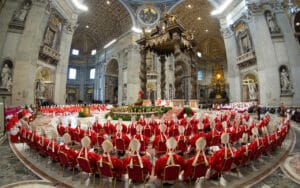Laborem Exercens is St. John Paul the Great extrapolation of the value of work. In this encyclical, global solidarity is addressed, and justice and the rights of workers are advocated for. Also important to the encyclical is the impact of technology on our lives, workers, families, and society. Laborem Exervens is timeless and valuable. It should be read by anyone seeking the ethical underpinnings of wisdom. John Paul the Great was a saint for our time, as he was in live color on television. Have you ever read a papal encyclical?

Laborem Exercens Arguments
Laborem Exercens means, in Latin, through work. It is an encyclical written by Pope John Paul II in 1981. In the encyclical, Pope John Paul II mentions three themes. The increased use of technology, which the Pope predicted would change the lives of workers on the scale of the Industrial Revolution, environmental issues, particularly the scarcity of resources like oil, and finally, the Pope said that people in the developing world should become more involved with the global economy.
In this encyclical, Pope John Paul II extolled the value and dignity of work. He traced it back to the first man, Adam. In the modern world of 1981, some situations degrade the dignity of work. John Paul II called these “threats to the right order of values.” For example, when work is a product to be sold or when workers are considered as instruments and not as the subject of work.
In Laborem Exercens, John Paul II set forth two priorities to discuss labor, capital, and property ownership: labor takes precedence over capital, and people are more important than things. John Paul II named two ideas: materialism and economism. Materialism puts property above people, and economism regards the value of labor only according to its economic purpose.
In the encyclical, John Paul II articulates the following rights of workers. Full employment, wages and benefits, unions, dignity of agricultural work, rights of disabled persons, and emigration and work. It talks in detail about each. Laborem Exercens concludes with a discussion of the spirituality of work.
John Paul the Great: A Saint for Our Times
John Paul II became a saint in April 2014. Becoming a saint in the Catholic Church first requires beatification. Becoming a saint is called canonization. For each step, a miracle must occur. John Paul the Second’s miracles were the healing of Sister Marie Pierre from Parkinson’s disease through his intercession (interesting because Pope John Paul II had Parkinson’s disease). The second miracle was the healing of Floribeth Mora Diaz’s brain injury after an aneurysm left her in terminal condition.
It is a little surreal to think that John Paul II was on television and became a saint. He lived in our times and traveled to 129 countries. He is also credited with helping to bring an end to communism. He was born in Poland, and his birth name was Karol Józef Wojtyła. He knew Lech Wałęsa, the leader of the Polish anti-communist Solidarity movement. Wałęsa credited Wojtyla for giving him the courage to demand change in Poland. In his youth, Wojtyla was an avid sportsman and an actor. Both helped him in his ministry.
Laborem Exercens Summary
Laborem Exercens is the seminal writing of the Pope on the dignity of labor and the effect of technology in modern times. The effect of technology, John Paul II says in encyclical, is massive and akin to the industrial revolution. When one considers the dislocating effect of technological advancement, one can see the Pope needed to write about it in 1981.








